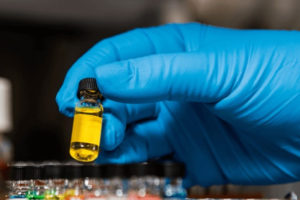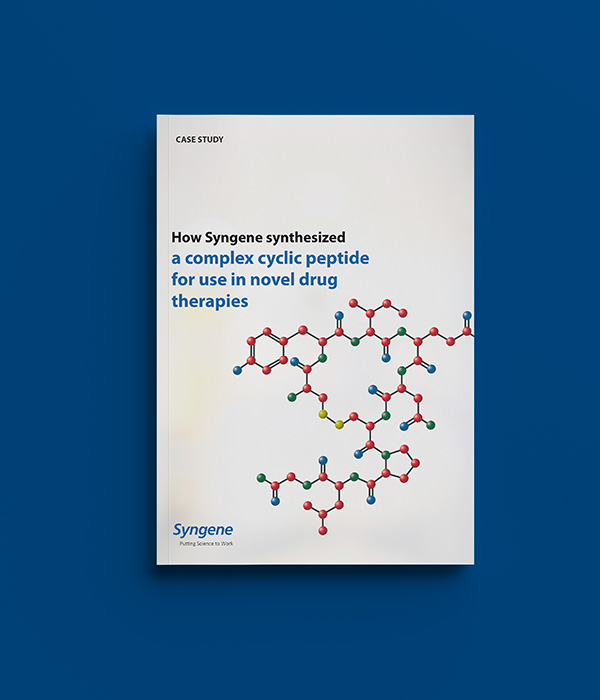Overview
Syngene partnered with a US client to synthesize a complex 11-mer cyclic peptide. The client’s peptide had several N-methylated amino acids, α,α-disubstituted amino acids, and unnatural amino acids, which posed several challenges in peptide synthesis. Syngene peptide chemists decided to relook at the best possible starting point for making the cyclic peptide. The team chose an unhindered junction for cyclization. For this purpose, the team identified four places where the peptide could be joined to form the cyclic peptide. The approach helped Syngene successfully deliver the complex peptide to the client for use in novel therapies.
Linear peptides versus cyclic peptides
Medicinal chemistry efforts aimed at ameliorating disease states start with mimicking Nature. While endogenous peptides such as hormones constitute a great starting point to the ‘road to cure,’ their less-than-ideal characteristics prove to be an Achilles heel in drug development. Characteristics include their inability to cross the membrane, short plasma half-life, faster clearance rates, and preference for parenteral administration routes. Such shortcomings of linear peptides can be overcome by cyclizing them.
Cyclic peptides, in contrast, have a favorable pharmacokinetic disposition, such as increased membrane permeability, among other characteristics, which is conducive for use as clinical candidates.
Cyclic peptides have anywhere between 5 to 14 amino acids and a molecular weight of between 400 to 2000 Da. In addition to small molecules and antibodies in the chemical space, cyclic peptides tick the right boxes for binding specifically (no non-specific binding). They can also disrupt protein-protein interactions because of their large surface area and avoid drug-drug interactions resulting from CYP inhibition. While a linear peptide may exist in many conformations, the cyclization strategy locks bioactive conformation by stabilizing the secondary structures.
Currently, more than 40 cyclic peptides are being used as pharmaceuticals, most obtained from Nature. The synthesis of the cyclic peptides can be achieved by bringing the ends of a linear peptide together or enticing two reactive functional groups from inside a linear peptide.
The Challenge
One of our US clients approached Syngene to work on a project related to synthesizing a complex 11-mer cyclic peptide which was buried in a patent. As a first step, Syngene peptide chemists decided to relook at the best possible starting point for making the cyclic peptide.
This peptide had several N-Methylated amino acids, α,α-disubstituted amino acids, and unnatural amino acids. According to literature, the coupling efficiency of N-Methylated amino acids and α,α-disubstituted amino acids in peptide coupling reactions is generally very poor compared to unsubstituted amino acids. These amino acids are not only difficult to couple, but some can be prohibitively expensive and not readily available.
The Solution
After carefully analyzing the structure, the Syngene team identified four points that could be joined to form the cyclic peptide. In the first two routes, we could not make the required linear peptide because we could not cross the critical joining point irrespective of the start point. In the third attempt, we succeeded in making the linear peptide, but the macrocyclization of the linear peptide failed due to Azlactone formation.
After many failed attempts, we chose an unhindered junction for cyclization. This is based on the criteria that the so-called ‘difficult coupling steps’ should be far removed from the polymer matrix (polymer matrices are known to be ‘problem spots’ with their influence on the reactant center minimized through ‘spacers’). We also ensured that the final Head to Tail cyclization was free from hindered amino acids. Apart from this, we introduced α,α – the disubstituted amino acids unit as a part of dipeptide.
Conclusion
Our novel approach helped us deliver the complex peptide that other partners could not. Further, the client acknowledged our scientific expertise in successfully delivering cyclic peptides for use in novel drug therapies.
To know more about our Medicinal Chemistry services or to contact our experts, please click here.







